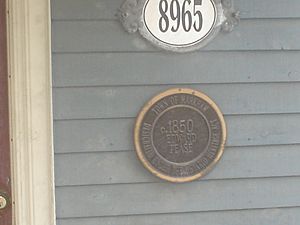Ontario Heritage Act facts for kids
The Ontario Heritage Act is a special law in Ontario, Canada. It was created on March 5, 1975. This law helps the government of Ontario and local cities protect important buildings, structures, and other places. These special places are called designated heritage properties. They are important because of their history, architecture, or cultural value.
Contents
What is the Ontario Heritage Act?
The Ontario Heritage Act is like a rulebook that helps save old and important places. It makes sure that buildings and areas with a lot of history are not destroyed or changed without careful thought. This helps us remember the past and learn from it.
Why do we need this law?
Imagine a really old house where a famous person once lived, or a beautiful old church that has been part of a town for hundreds of years. Without a law like the Ontario Heritage Act, these places could be torn down to build something new. This law helps make sure that doesn't happen easily. It protects places that tell us stories about how people lived long ago.
Protecting a Heritage Property

When a place is listed as a heritage property under this law, it means it's officially recognized as important. If someone owns one of these special places, they need to ask their city government for permission before making big changes. This includes changing important parts of the building or tearing it down. This rule helps keep the historical look and feel of the property safe.
How the law changed over time
The Ontario Heritage Act has been updated to make it even stronger.
Before 2005
Before 2005, owners of heritage buildings could sometimes still tear them down. Even if the city government said no, the owner could wait 180 days. After this time, if they still disagreed with the city, they could go ahead and destroy the building. This meant some important places were still lost.
After 2005
In 2005, the provincial government changed the law. Now, if a city government says no to tearing down a heritage building, the owner cannot just wait and then destroy it. If the owner still wants to make changes or tear it down, they can ask a group called the Conservation Review Board for help. This Board listens to both sides and makes a decision. If the Board also says no, then the owner is not allowed to destroy the building.
The updated law also says that owners of heritage buildings must take good care of them. This means they need to make sure the buildings stay in good condition and don't fall apart.
Challenges with the Act
Even with this important law, there can be some challenges.
Protecting the right places
Sometimes, a city might try to protect a place that isn't really a historical building. They might do this because they don't want someone to build something new there, even if the place itself isn't very old or special. For example, one city tried to protect a golf course because someone wanted to build houses on it. The law is meant to protect history, not just stop new construction.
Balancing religion and history
Many old churches in Ontario are protected heritage properties. Sometimes, people who use these churches need to make changes to the buildings because of their religious practices. The city government needs to be careful. They must allow people to practice their religion freely, but also make sure the important parts of the building are still taken care of. It's about finding a balance between faith and history.
Federal government buildings
Another challenge is that some buildings in Ontario belong to the Government of Canada. These buildings are not protected by the Ontario Heritage Act. The Government of Canada has its own laws to protect some of its buildings, but not all of them. This means some important federal buildings in Ontario might not have the same level of protection as others.
Images for kids
-
Old City Hall in Toronto in 1907. Its proposed demolition in the 1960s helped people realize the importance of saving old buildings, leading to laws like the Ontario Heritage Act.
-
Plaque on the Griffin House in the Dundas Valley Conservation Area, showing that the building is protected under the Act.




